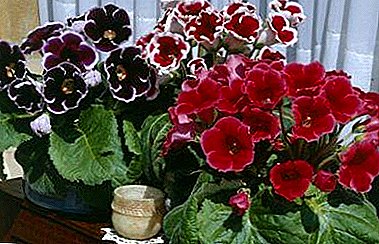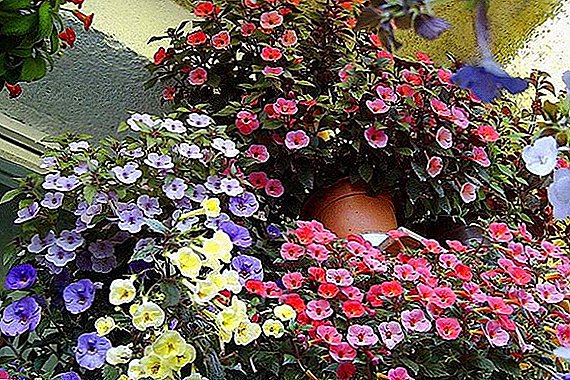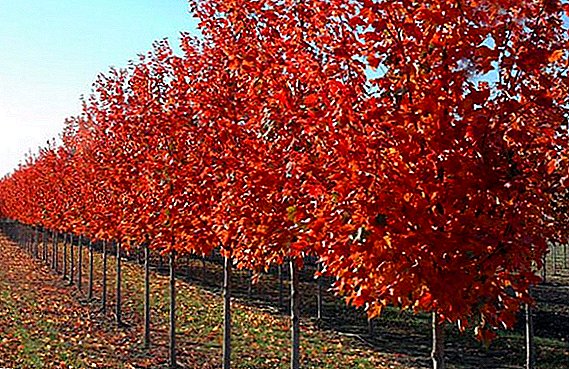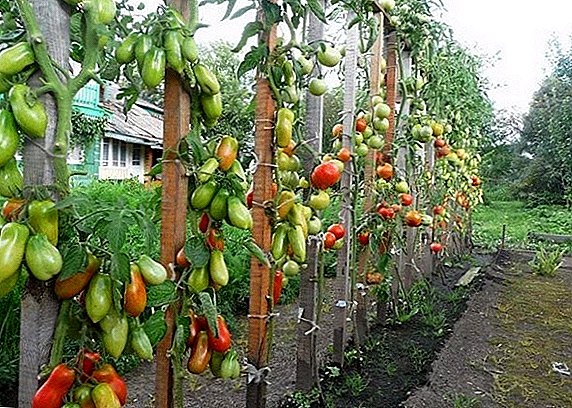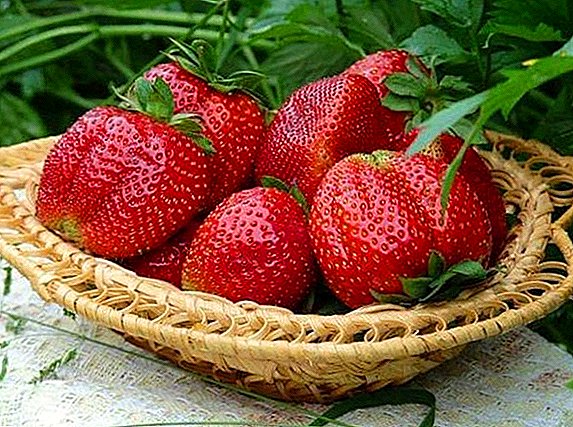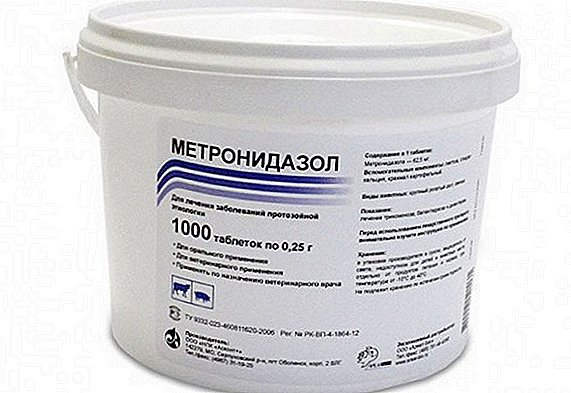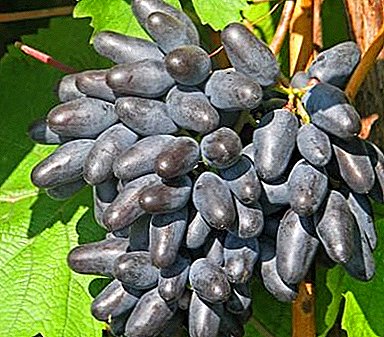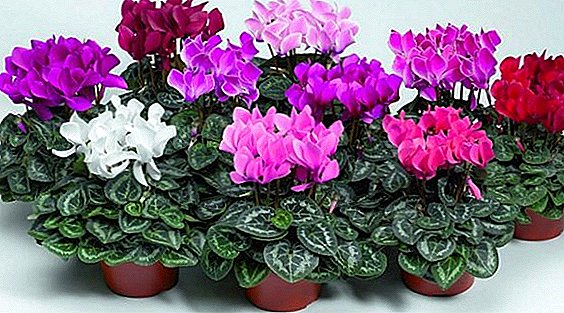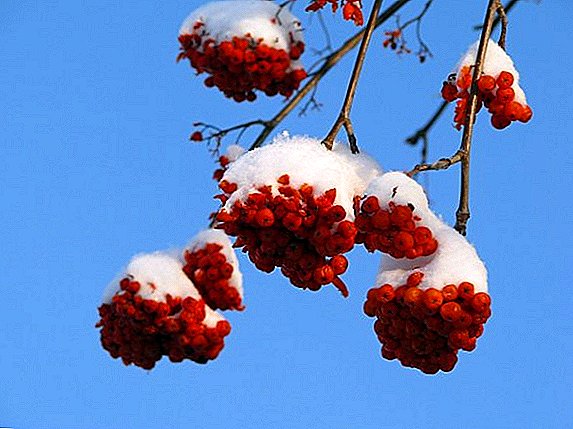 Red rowan, its health benefits, contraindications and possible harm from its use have been known to mankind for several thousand years.
Red rowan, its health benefits, contraindications and possible harm from its use have been known to mankind for several thousand years.
The unique qualities of mountain ash provided her a special place in traditional medicine, cooking and cosmetology. Red Rowan continues to attract attention and enjoy great popularity.
Did you know? Ancient Greek myths tell about the origin of bright berries and feathery leaves of mountain ash from feathers and drops of eagle blood, which fought with demons, saving the cup of the goddess of youth Hebe. Celtic Druids attributed rowan to twelve sacred trees. Rowan berries (“Food of the Gods”) could heal the wounded, and each eaten berry brought a year of life. German-Scandinavian and Slavic mythologies considered mountain ash to be a female tree (the goddess Freyja wore a necklace from mountain ash) as a receptacle for Perun's lightning, a talisman tree, a symbol of fertility and love.
Chemical composition and nutritional value of red rowan
 The usefulness of red rowan has long been known. Rowan is a perennial plant (it can live up to 200 years), and all of it (branches, bark, flowers, leaves, fruits) is literally saturated with vitamins, minerals and other useful substances.
The usefulness of red rowan has long been known. Rowan is a perennial plant (it can live up to 200 years), and all of it (branches, bark, flowers, leaves, fruits) is literally saturated with vitamins, minerals and other useful substances.
Rowan fruits are especially rich in vitamins. With their help, you can fill the vitamin deficiency in winter and early spring.
Chemical analysis shows that 100 grams of mountain ash contain:
- 81 mg of ascorbic acid is almost twice as much vitamin C as in lemons and oranges;
- 9 mg of β-carotene, i.e., superior to many carrot varieties;
- 2 mg tocopherol;
- 0.5 mg of nicotinic acid (vitamin PP) - one of the leading places among fruit crops;
- 0.2 micrograms of folic acid (vitamin B9);
- 1500 mcg of retinol (vitamin A) - takes the fifth place after fish oil, beef and cod liver and carrots;
- 0.05 mg thiamine (vitamin B1);
- 0.02 mg riboflavin (vitamin B2);
- minerals (magnesium (331 mg), potassium (230 mg), copper (120 μg), phosphorus (17 mg), sodium (10 mg), calcium (2 mg), manganese (2 mg), iron (2 mg)) .
The energy value of 100 g of berries - 50 kcal (81.1 g is water, 8.9 g - carbohydrates, 0.2 g - fats, 5.4 g - dietary fiber, etc.). Fresh fruits of mountain ash are practically not eaten: the presence of sorbic acid (a natural preservative with antimicrobial properties) gives the berries a bitter bitterish.
 When processing berries (in the manufacture of jam, tinctures, etc.), as well as under the influence of cold, this acid breaks down easily, the bitterness disappears, a pleasant tartish taste remains (mountain ash red is acceptable for children in the form of jam, marmalade, pastila, jam, etc.) .
When processing berries (in the manufacture of jam, tinctures, etc.), as well as under the influence of cold, this acid breaks down easily, the bitterness disappears, a pleasant tartish taste remains (mountain ash red is acceptable for children in the form of jam, marmalade, pastila, jam, etc.) .
Did you know? The scientific name of the mountain ash is red - Sorbus aucuparia. Its origin is connected with the Celtic word "tart" - "sor" and Latin "aucupari" - "what birds like". Slavic names "rowan", "pea" comes from "ripple" (freckle, pockmarked) because of the bright color of rowan berries. V. Dahl also produces the name of mountain ash from "spring" - clean, peel. Slavs believed that mountain ash cleans the air, water, and the surrounding area from all bad, nasty.
Useful properties of mountain ash red for the body
 The wide spread of mountain ash in Eurasia and North America, the presence of more than 100 species of this plant facilitated the work of breeders, in the course of which new varieties appeared (large-fruited, without bitterness, honey, etc.) that are actively used in cooking.
The wide spread of mountain ash in Eurasia and North America, the presence of more than 100 species of this plant facilitated the work of breeders, in the course of which new varieties appeared (large-fruited, without bitterness, honey, etc.) that are actively used in cooking.
Red ash (ordinary) of all rowan varieties is most often and actively used for medicinal purposes because of its pronounced beneficial properties:
- an abundance of vitamins and minerals (prevention of vitamin deficiency);
- bactericidal properties of phytoncides (prophylaxis and counteraction to intestinal infections, inhibition of fungal growth);
- gelation property (prophylaxis of gas formation, removal of excess carbohydrates);
- the presence of sorbitol (help with constipation, safe for diabetics);
- diuretic action (treatment of urolithiasis, inflammation of the urogenital system, prevention of prostatitis);
- the ability to reduce the level of bad cholesterol (normalization of pressure, strengthening the vessels of the heart and brain, prevention of strokes, heart attacks, hypertensive crises);
- the presence of potassium and magnesium contributes to the work of the heart muscle;
- high pectin content (elimination from the body of heavy metals, harmful chemical compounds, etc.);
- the presence of vitamins E, A, PP, K, etc. (the red mountain ash ideally put together useful properties for women of all ages - normalizes the menstrual cycle, eliminates irregularities during menopause, increases blood clotting, rejuvenates the skin, normalizes metabolic processes, removes toxins from the body, has anti-cancer effect, allows to reduce excess weight, etc.).
How to procure and store medicinal raw materials rowan
 In the form of medicinal raw materials harvested flowers, twigs, fruits, leaves and rowan bark. All of them in one way or another have medicinal properties.
In the form of medicinal raw materials harvested flowers, twigs, fruits, leaves and rowan bark. All of them in one way or another have medicinal properties.
The shelf life of raw materials is one year (for dried berries - two years).
Preparation is made:
- in early spring (at the beginning of sap flow) - harvest bark. For medical purposes suitable bark of young annual branches. The branches cut shears, make a longitudinal section in the bark and separated from the branch. Dried in the shade or dryers;
- In spring, young twigs with buds are cut. After they are cut into pieces (1 cm) and dried;
- during the flowering of mountain ash (in May), flowers are harvested (it is necessary to pluck inflorescences) and bark;
- at the end of summer (August), the green leaves of the mountain ash are cut off (the concentration of vitamin C at this time of year is the maximum in them). Leaves after harvesting are subject to drying.
 Collecting the main source of the healing properties of mountain ash - its berries - is a special and unhurried process. It is right to gather mountain ash in the morning in dry and clear weather. Dates of berry collection depend on how raw materials will be stored (fresh, dried, dried, etc.):
Collecting the main source of the healing properties of mountain ash - its berries - is a special and unhurried process. It is right to gather mountain ash in the morning in dry and clear weather. Dates of berry collection depend on how raw materials will be stored (fresh, dried, dried, etc.):
- September-October - it's time for harvesting berries, followed by fresh storage and drying. Berries must have time to remove before the first frost, to save more nutrients. Gather berries with brushes, cutting them with shears. Brushes hang for storage in a cool place.
More often berries are dried (so they retain a maximum of useful properties, water evaporates, the concentration of trace elements increases). It is necessary to dry rowan in the shade or in the dryer, stirring occasionally (dry until the rowan stops sticking when squeezed in the hand).
Finished rowan will be better stored in glass jars with a tight lid. Dry mountain ash is the basis for the manufacture of mountain ash powder - you just need to grind it. Dry rowan is stored without losing its qualities for two years;
- October-November (after the first frosts) - berries are collected for culinary purposes and preparations (the bitterness is given away, easily separated from the stalks). The harvested berries are frozen, boiled jam from them and tinctures are prepared.
Frozen berries are great for drying - for three minutes a kilo of rowan berries is poured with boiling water and soaked for 12 hours in cold water (changing it periodically). After draining the water, dry the mountain ash and pour 250 g of sugar, then leave it in the room for 20 hours. Drain the extracted juice, add another 250 g of sugar and repeat the procedure.
Drain the juice, pour hot syrup (to cover all the berries), heat to 90 degrees and stand on such a fire for seven minutes. After the berries, remove, cool and dry in the oven two times for half an hour at 70 degrees. After the berries have cooled, six hours to dry it at 30 degrees.
 Another common way to preserve vitamins - juicing. There are several methods of its manufacture. The first option is for quick consumption of the drink (not stored for a long time): kilogram of washed berries pour 600 grams of sugar and let it stand for four hours. Boil and boil for 30 minutes. You can use a juicer.
Another common way to preserve vitamins - juicing. There are several methods of its manufacture. The first option is for quick consumption of the drink (not stored for a long time): kilogram of washed berries pour 600 grams of sugar and let it stand for four hours. Boil and boil for 30 minutes. You can use a juicer.
The second option - the preparation of juice for storage. Ripe the berries to sort and wash several times, add water and warm to 90 degrees. Berries soften, cool, rub through a sieve or grind in a meat grinder.
Strain the mixture and boil it (to make the juice more sweet, you can mix the sugar syrup). Such juice is stored corked in sterilized jars.
Use in folk medicine: treatment of red rowan
Red mountain ash in folk medicine has long been used. Juice, fruits, bark, flowers in fresh and dried form, decoctions, tinctures, ointments, lotions, etc. are used.
Did you know? Our ancestors have learned to use a huge amount of phytoncides contained in mountain ash. In the absence of drinking water, a few freshly cut branches of mountain ash, set in the swamp water for two to three hours, make it quite suitable for use. Similarly, you can do with tap water. In veterinary medicine, rowan leaves feed animals. In agriculture, piled up potatoes are stored with rowan leaves (putrefactive bacteria are killed).
Rowan juice
 Rowan juice, like a berry, contains vitamins, retains its beneficial properties, but also has the same contraindications.
Rowan juice, like a berry, contains vitamins, retains its beneficial properties, but also has the same contraindications.
Therefore, mountain ash juice (very pleasant to the taste) is recommended to be taken only after consulting a doctor.
Most often, and most successfully, rowan juice helps in the treatment of:
- hemorrhoids. The treatment can take place only in autumn - the juice from freshly squeezed berries is necessary. To relieve aggravation of hemorrhoids, mountain ash juice is drunk three times a day in a cup, washed down with plain water;
- low acidity, atherosclerosis, liver disease. 30 minutes before eating you need to drink a teaspoon of rowan juice;
- rheumatism. It helps three times a day (before eating) a cocktail of rowan juice, milk (1/3 cup) and a tablespoon of honey;
- constipation. Pure rowan juice to drink 50-70 g three times a day (in combination with honey, the effect will be better);
- throat diseases (sore throat, laryngitis, pharyngitis, etc.). Rinsings will help with warm water (one glass) with the addition of mountain ash juice (1 tbsp. L.);
- endocrine diseases. Three times a day before eating drink a tablespoon of rowan juice.
Important! Permanent use of rowan juice has a contraceptive effect, relieves swelling of the limbs.
Rowan Tea
 Rowan tea is especially useful for beriberi, colds and flu epidemics. The healing properties of red rowan are fully preserved in tea.
Rowan tea is especially useful for beriberi, colds and flu epidemics. The healing properties of red rowan are fully preserved in tea.
It has a preventive and therapeutic effect depending on the composition:
- from rowan leaves - choleretic, diuretic and anti-edematous action. Brew 300 g of fresh or 100 g of dry leaves per liter of boiling water. Insist 30 minutes, drink three times a day;
- from the fruits of mountain ash and wild rose - cough. Ingredients (one tablespoon each) pour boiling water (two glasses) in a thermos. Insist eight hours. To enhance the effect add honey and grated ginger. Drink two or three times a day for half a cup;
- dry rowan berries - treatment of diarrhea. 10 g of dry berries pour 200 ml of boiling water and boil for 15 minutes. Drink twice a day (morning and evening) 50 ml.
Important! Brewing tea from the dry fruits of mountain ash, it is best to use a thermos instead of a teapot. Another option is to boil it over low heat. This will allow to keep the heat longer, at which the mountain ash "will give" the decoction a maximum of useful substances.
Remedy for warts
 The causes of warts are not always clear. Doctors believe that the main factor that causes the appearance of warts is a decrease in immunity (due to improper diet, stress, allergies, etc.).
The causes of warts are not always clear. Doctors believe that the main factor that causes the appearance of warts is a decrease in immunity (due to improper diet, stress, allergies, etc.).
Treatment of warts is associated with the adoption of a variety of drugs, which does not always have a positive effect on the body (especially children). The use of natural remedies is preferred.
There are different recipes, they are all simple:
- rowan juice lubricate warts (until they disappear);
- chop the rowan berries into a mush, steam out the skin and put the berry mass on the wart at night, wrap in cellophane and gauze. In the morning take off. The course of treatment is seven days;
- cut fresh rowan berries and cut to the wart. Berry secure with plaster. Every day to change the berry. The course of treatment is seven to eight days.
Infusion for colds
 The use of infusions of red ash from the cold is widely known.
The use of infusions of red ash from the cold is widely known.
The main requirement in the manufacture of medicinal infusion - do not boil the fruit, otherwise many useful properties will be lost.
One of the recipes for infusion of dry rowan berries:
- Pour 500 ml of water into enameled ware and pour 9 g (1 tablespoon) of rowan berries, cover tightly;
- put in a water bath (for 20 minutes);
- remove and insist one hour, after straining, drink four doses of half a cup during the day.
Adult cold patients can be recommended. strong infusions of mountain ash (on cognac, medical alcohol, vodka). Making such infusions is easy: liter of vodka per 200 g of fresh berries. Rowan ash filled in a glass container, pour vodka and cork. Put for 14 days in a dark place (several times the bottle should be shaken and turned over). After filtering, take 30 g of tincture three times a day before meals.
Did you know? For the first time, mountain ash liqueur on vodka under the Smirnov brand was shown in 1889 at the World Exhibition in Paris. It was not possible to forge a very popular tincture - for its preparation, a unique sweet variety of rowan Nevezhensky, accidentally bred in Vladimir province, was used.
Infusion with gastritis
 The infusion of mountain ash is effective with low acidity. For infusion need fresh rowan (five glasses of berries) and three glasses of sugar. Mash berries, mix with sugar and leave for eight hours warm. After the juice stands out, boil for 30 minutes over low heat, stirring occasionally (make sure not to boil).
The infusion of mountain ash is effective with low acidity. For infusion need fresh rowan (five glasses of berries) and three glasses of sugar. Mash berries, mix with sugar and leave for eight hours warm. After the juice stands out, boil for 30 minutes over low heat, stirring occasionally (make sure not to boil).
Drain and strain. To accept means on the table spoon 4 times a day before food within a month.
For diabetics apply an infusion of 400 g of fresh berries and two liters of boiled water: pour the pounded berries with water, shake well and insist for four hours. Take an infusion of a teaspoon before eating (no later than 30 minutes).
Infusion with anemia
For anemia well helps infusion of rowan leaves. 30 g of fresh leaves are crushed in a blender, then poured a glass of boiling water and infused for one hour. The portion is divided into three parts and is drunk per day.
With abundant background menstruation frayed in rowan berries of mountain ash (2 tbsp. L.), pour 400 ml of boiling water, insist an hour and a half and take over the course of the day.
Tincture with atherosclerosis
 With atherosclerosis helps complex an infusion of dried mountain ash (20 g), flax seeds (1 tbsp. l.), chopped strawberry leaves and marigold flowers. All mix and pour boiling water (0.5 l), hold on a water bath for 15 minutes. Then insist another 40 minutes. Take three times a day for half a cup before eating. The course of treatment is two to three weeks.
With atherosclerosis helps complex an infusion of dried mountain ash (20 g), flax seeds (1 tbsp. l.), chopped strawberry leaves and marigold flowers. All mix and pour boiling water (0.5 l), hold on a water bath for 15 minutes. Then insist another 40 minutes. Take three times a day for half a cup before eating. The course of treatment is two to three weeks.
Broth with scurvy and whooping cough
For the treatment of scurvy and whooping cough prepare the broth: dry ash collection (15 g leaves and 15 g berries) pour water (200 ml), boil and boil for 10 minutes. Insist two hours, cool and filter. Drink twice a day for half a cup.
Broth with hemorrhoids
With this disease, effective help will rowan juice decoction (eliminate constipation, strengthen the walls of blood vessels, stop bleeding, heal wounds). For cooking broth It takes a kilogram of berries and a liter of water. Berries poured water and put on a small fire. After boiling, remove from heat, cool and rub through a sieve. Stir 0.5 kg of sugar in the juice and boil. Drink three times a day, 100 ml.
In addition to juice, for the treatment of hemorrhoids actively apply mountain ash: Pour five tablespoons of chopped bark with water (0.5 l), boil and boil for two hours. Drink 30 ml three times a day before meals.
How to use rowan in home cosmetology
 The use of red rowan in home cosmetology has a long tradition. People used the bactericidal, healing, regenerating properties of mountain ash. Juice, fruit pulp, decoctions are traditionally used in the form of lotions, masks, compresses, creams, etc.
The use of red rowan in home cosmetology has a long tradition. People used the bactericidal, healing, regenerating properties of mountain ash. Juice, fruit pulp, decoctions are traditionally used in the form of lotions, masks, compresses, creams, etc.
The result is noticeable immediately - irritation is removed, the pores are narrowed, the skin is slightly bleached and loses oily shine, fine wrinkles are smoothed out, the skin becomes more elastic. If the red rowan does not cause allergic reactions and there are no other contraindications, you can safely use natural cosmetology.
Nourishing face mask
In the manufacture of masks for dry and normal skin, the main ingredient is fresh rowan, used butter, cream, honey, etc .:
- растереть сливочное масло (1 ст. л.) с желтком и медом (1 ч. л.). В полученную массу добавить раздавленную в пюре рябину (2 ст. л.). Такую маску наносят на 30 минут, после чего протирают лицо салфеткой;
- смешать рябиновый сок (1 ч. л.) со сливочным маслом (1 ст. л.). Apply for 20 minutes and rinse with linden extract.
For oily skin, the mask is made lighter:
- rowan berries (1 tbsp. l.) knead, combine with kefir (2 tbsp. l.) and lemon juice (1 tbsp. l.). The mask is applied for 20 minutes and washed off with warm water.
Lotion is also good for oily skin (puree of rowan berries (2 tablespoons), honey (1 tablespoons), apple cider vinegar (1 tsp), vodka (1 tablespoons) and water (200 ml)). 
Important! When using masks, it should be borne in mind that the combination of mountain ash and carrots can stain the skin and give it an orangish shade. If you are going to go out after the procedure, it is better to temporarily refrain from such a mask or do it in the evening.
Toning mask
Toning masks will be useful for all skin types. Prepare them simply:
- Mix one teaspoon of rowan juice, honey and vegetable oil with egg yolk. Apply the mask for 20 minutes. For best results, the mask is combined with a steam bath. Course duration - 8 sessions;
- mix mush from rowan berries (2 tbsp. l.) with honey (1 tsp.) and hot water (2 tsp.). Apply to skin for 20 minutes. Top can be covered with a warm compress. Course duration - 12 procedures. Keep in mind that such a toning mask has a whitening effect.
Excellent tonic - frozen rowan juice. Daily use of frozen juice cubes with a light massaging will rejuvenate the skin and raise its tone.
Rejuvenating mask
For rejuvenating fading skin mashed rowan berries will be useful. Apply a lot of berries for ten minutes and rinse with cold water. Effective as a mask of rowan puree and grated carrots (worn for 15 minutes). If the skin is oily, then whipped egg white is added to the mountain ash.
Good anti-aging effect for problem skin is a mask of rowan juice, grated walnuts, plantain broth and St. John's wort (all for 2 tablespoons). All ingredients are mixed and applied for 20 minutes, washed with warm water.
Possible harm and contraindications
Despite all the usefulness and high medicinal properties of red rowan, you should be aware of the fact that there are also contraindications for which the negative consequences of using this remedy are possible.
Reduce the use of mountain ash to a minimum should people:
- with increased acidity of the stomach;
- with urolithiasis (it is possible to provoke the movement of stones);
- hypotensive;
- with a gastric or duodenal ulcer;
- after a stroke / heart attack;
- with ischemic heart disease;
- children under the age of three;
- with individual intolerance of mountain ash.
 Red rowan during pregnancy and breastfeeding is also undesirable in the diet, since it increases the likelihood of involuntary miscarriage, allergic reactions in an infant.
Red rowan during pregnancy and breastfeeding is also undesirable in the diet, since it increases the likelihood of involuntary miscarriage, allergic reactions in an infant.

